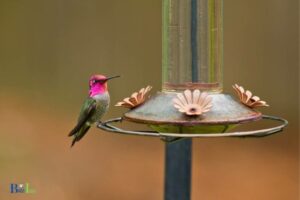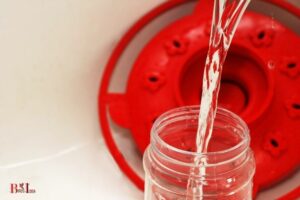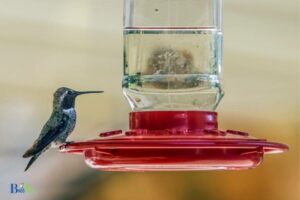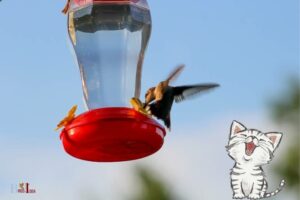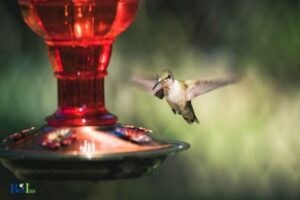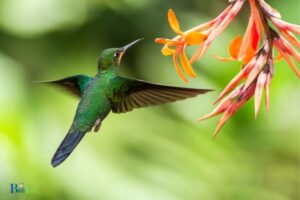Are Bees Swarming My Hummingbird Feeder? Yes, 5 Causes!
Yes, bees can swarm your hummingbird feeder.
They are attracted to the sweet nectar, just like hummingbirds.
Bees are attracted to hummingbird feeders as they contain sugary nectar that provides them with energy.
However, they can become a nuisance and prevent hummingbirds from feeding.
To maintain a peaceful environment for hummingbirds, ensure that you keep your feeders away from direct sunlight, as bees prefer warm and sunny locations.
In addition, bee guards can be installed to prevent bees from accessing the nectar, while a moat filled with water makes it difficult for them to reach the feeder.
Furthermore, smaller feeding ports can prevent bees from entering, and regularly cleaning the feeder will minimize the attraction of bees.
5 Possible Causes of Bees Swarming My Hummingbird Feeder
| Possible Causes | Solutions | Prevention Methods |
|---|---|---|
| High Sugar Content | Dilute sugar solution | Use a 4:1 water to sugar ratio |
| Bright Colored Feeder | Change to a less attractive color | Avoid red and yellow feeders |
| Food Spillage | Clean feeder regularly | Use a drip-proof feeder design |
| Close Proximity to Bee Nest | Relocate feeder | Place feeder far from bee nests |
| Bee Attracting Plants Nearby | Move feeder away from plants | Choose hummingbird-friendly plants |
Key Takeaway
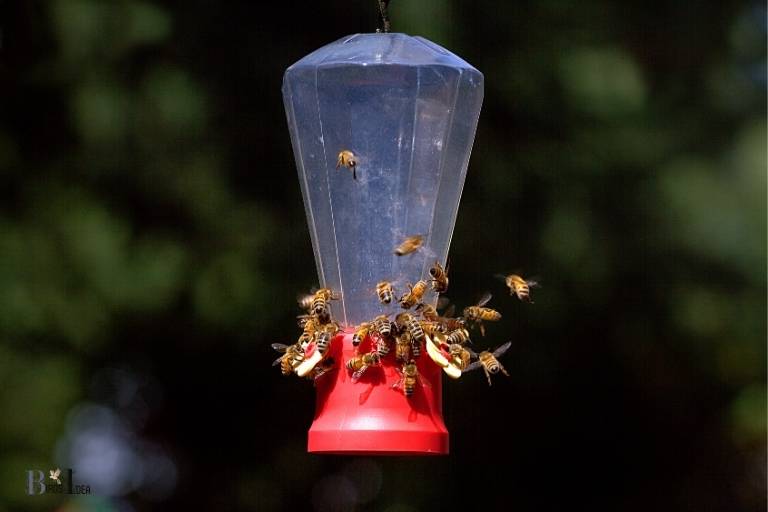
Five Facts About: Bees Swarming My Hummingbird Feeder
How to Deter Bees From Swarming a Hummingbird Feeder?
Bees swarming your hummingbird feeder can be a frustrating problem, but fortunately, there are several effective methods to deter bees while still allowing hummingbirds to enjoy the feeder.
By making simple adjustments and taking preventative measures, you can keep those pesky insects away and maintain a peaceful environment for your hummingbirds.
- Choose the right feeder: Opt for a hummingbird feeder with bee guards, which are special mesh or plastic covers that prevent bees from accessing the nectar while allowing the hummingbirds to feed easily.
- Adjust the feeder location: Bees often find feeders by sight, so it’s essential to relocate your feeder every few days to confuse the bees and make it harder for them to find the feeder.
- Offer an alternative food source: Place a small dish filled with sugar water away from the hummingbird feeder, which will attract the bees and keep them occupied, giving your hummingbirds a chance to feed in peace.
- Reduce the sugar concentration: Hummingbirds can tolerate a lower sugar concentration in their nectar, so try reducing the sugar-to-water ratio in your feeder from 1:4 to 1:5. This will make the nectar less appealing to bees but still suitable for hummingbirds.
- Keep the feeder clean: Regularly clean your hummingbird feeder – especially the feeding ports – to ensure there is no nectar build-up, which can attract bees.
Ultimately, maintaining a bee-free environment for your hummingbird feeder requires persistence and diligence.
By following these suggestions, you’ll create a more inviting space for your hummingbirds and discourage bees from overtaking their feeder.
“Hummingbirds are attracted to red, while bees are drawn to yellow. Choosing a feeder that has more red and less yellow can help deter bees.”
– BirdWatching HQ
What Are the Benefits of Bee Swarming for Hummingbird Feeders?
Bee swarming around hummingbird feeders can be seen as a nuisance, but it also has some benefits:
- Pollination Assistance: When bees swarm your hummingbird feeder, they may also visit nearby flowers, pollinating them and promoting a healthy ecosystem in your garden. This helps to maintain the growth of various plants, flowers, and fruits in your yard.
- Natural Predator Attraction: Bees can attract other creatures, such as birds and dragonflies, that feed on them. This can help to control pest populations, create a more diverse ecosystem, and provide a natural way to manage unwanted garden insects.
- Resource Sharing: Bees and hummingbirds both consume nectar. By sharing the hummingbird feeder, they are helping to maintain the balance of nectar supply in the surrounding area.
To minimize the impact of bee swarming on your hummingbird feeders, consider the following tips:
- Use bee-resistant feeders: Some hummingbird feeders are designed to be more difficult for bees to access, yet still allow the hummingbirds to feed comfortably.
- Add a water source: Providing a separate shallow water dish can help to distract the bees from the feeder, as they need water to cool down their hive and drink.
- Adjust the nectar concentration: Hummingbirds prefer a slightly higher sugar concentration in their nectar than bees do. By adjusting the ratio to about one part sugar to four parts water, bees may be less attracted to the feeder.
In conclusion, while bee swarming at hummingbird feeders can be bothersome, it has benefits that can contribute to a healthier and more diverse garden.
By following some simple tips, you can maintain a balance that allows both bees and hummingbirds to coexist and thrive.
What Are the Risks of Bee Swarming for Hummingbird Feeders?
Bee swarming around hummingbird feeders can pose a few risks to both the birds and the bees themselves.
When bees become attracted to the sugar-water in hummingbird feeders, it can create an uncomfortable environment for hummingbirds, often discouraging them from visiting the feeder.
Moreover, it can also create unfavorable circumstances for bees, such as drowning in the feeder or becoming trapped.
Additionally, large swarms of bees increase the chances of stings, which can be dangerous for humans, pets, and other wildlife around the feeder.
Risks for hummingbirds:
- Difficulty accessing the feeder
- Discouragement from visiting the feeder
Risks for bees:
- Drowning in the sugar-water
- Becoming trapped in the feeder
To minimize the risks associated with bee swarming around hummingbird feeders, it is essential to take preventative measures.
This may include using bee-resistant feeders, maintaining cleanliness, avoiding bright yellow feeder colors, and placing the feeder in a shady area.
These steps can help to maintain a harmonious coexistence between bees and hummingbirds, while also ensuring the safety of humans and other wildlife.
How to Protect Hummingbird Feeders From Unwanted Bee Swarms?
Protecting hummingbird feeders from unwanted bee swarms requires a few simple yet effective strategies.
Bees, like hummingbirds, are attracted to the sugar content in the feeder.
However, taking some precautionary measures can help in keeping the bees at bay while still providing a safe and enjoyable experience for hummingbirds.
- Choose bee-resistant feeders: Some hummingbird feeders are specifically designed to deter bees. Look for feeders with a built-in moat or barrier to prevent bees from reaching the nectar.
- Adjust the sugar concentration: Reduce the sugar concentration in the nectar mixture to 1:5 (1 part sugar to 5 parts water) as bees prefer sweeter nectar.
- Use red food coloring: Bees are less attracted to the color red; make sure your feeder is predominantly red or add some red food coloring to the solution to deter bees without affecting hummingbirds.
- Clean up spills: Clean any spills of nectar on the feeder or surrounding area to avoid attracting bees.
- Move the feeder: If the bees keep coming, try relocating the feeder to a different location. Bees are creatures of habit and might not follow the feeder when moved.
- Provide a separate bee feeder: To keep bees away from hummingbird feeders, set up a separate feeder filled with a sweeter nectar solution (1:3 ratio) for bees at a distance from the hummingbird feeder. This can help in diverting the bees away from the hummingbirds’ supply.
By employing these strategies, you can effectively protect hummingbird feeders from unwanted bee swarms while still providing a safe and enjoyable environment for hummingbirds to feed.
What Are the Best Practices for Keeping Bees Away From Hummingbird Feeders?
To protect your hummingbird feeder from being swarmed by bees, incorporate these best practices to ensure that your hummingbirds can continue to feed safely while deterring bees from invading their space.
By using these methods, you will create a more enjoyable and hassle-free environment for the hummingbirds, and yourself as well.
- Choose the right feeder: Opt for bee-resistant hummingbird feeders which feature built-in guards, bee guards, or feeders with a moat around the feeding ports. These designs limit access for bees while allowing hummingbirds to feed undisturbed.
- Relocate your feeder: Changing the feeder’s location can disorient bees, making it harder for them to locate it. Also, place it in a shady spot, as bees tend to prefer sunlit areas.
- Adjust the sugar ratio: Bees are more attracted to sweeter solutions, so consider reducing the sugar-to-water ratio in your hummingbird nectar. A ratio of 1:4 (1 part sugar to 4 parts water) is ideal for keeping bees at bay while still providing adequate sustenance for hummingbirds.
- Avoid yellow: Bees are drawn to the color yellow, so avoid using hummingbird feeders or accessories with this hue.
- Keep it clean: Regularly clean and refill your feeder to avoid any sugary residue that could attract bees. A clean feeder is not only less appealing to bees but also healthier for the hummingbirds.
Pro tip: Planting bee-friendly flowers away from the feeder can serve as an alternative source of nectar for the bees, reducing their interest in your hummingbird feeder.
birdsidea
According to the Honeybee Conservancy, a single bee can visit up to 1,000 flowers in a day, which means that a group of bees can quickly dominate a hummingbird feeder and scare away the hummingbirds.
birdsidea
Why Do Bees Swarm Around Hummingbird Feeders?
This can be frustrating and confusing, but there are a few reasons why bees are drawn to hummingbird feeders.
One reason is that hummingbird feeders typically contain a sugary solution that is similar to the nectar that bees typically feed on.
Another reason is that bees are attracted to bright colors, and many hummingbird feeders are brightly colored to attract hummingbirds.
Finally, bees are social insects, and when one bee discovers a food source, it will alert its hive mates, causing more bees to swarm around the feeder.
If you want to keep bees away from your hummingbird feeder, there are a few things you can try.
One option is to choose a feeder with bee guards or bee-resistant ports. Another option is to place the feeder in a shady area, as bees prefer sunny spots. You can also try using a different type of sugary solution that is less attractive to bees.
Ultimately, it is important to remember that bees are important pollinators and play a crucial role in our ecosystem.
If you can coexist peacefully with them around your hummingbird feeder, it may be best to simply enjoy their presence and allow them to do their important work.
- Avoid using pesticides near your hummingbird feeder as they can harm both bees and hummingbirds.
- Clean your feeder regularly to prevent fermentation, which can attract bees.
- Bees are most active during the day, so consider taking your feeder down overnight to reduce bee activity.
What can you use to keep bees away from your hummingbird feeder?
If you have a hummingbird feeder and are struggling to keep bees away, you’re not alone.
Bees are attracted to the sweet nectar and may swarm around the feeder, making it difficult for hummingbirds to access the food.
But there are several things you can do to keep bees away from your hummingbird feeder.
Use Bee Guards: Some hummingbird feeders come with bee guards, which are small mesh screens that cover the ports where the nectar is dispensed. These guards prevent bees from accessing the nectar while still allowing hummingbirds to feed.
Move the Feeder: Try moving the feeder to a different location, away from other sources of nectar that might be attracting bees. For example, move the feeder from a flower garden to a more open area.
Use Distractions: Bees are also attracted to the color yellow, so try placing a yellow dish or flower near the feeder to distract them.
Use Water: Bees need water, just like any other creature. By placing a shallow dish of water next to the hummingbird feeder, bees can drink from it and won’t be as interested in the nectar.
Overall, there are several ways to keep bees away from your hummingbird feeder. Try these tips and see which works best for you.
- Bees are essential pollinators, so it’s important not to harm them unnecessarily.
- If you don’t want to use chemicals or pesticides, try using natural repellents such as peppermint or cinnamon essential oils.
What calms honey bees?
While bees are crucial for pollination, it can be scary when they swarm around you or your pets.
Instead of using harmful insecticides to get rid of them, there are a few ways to safely calm honey bees and avoid agitating them.
One of the simplest ways to calm honey bees is by smoking them. Beekeepers often use a bee smoker to release smoke near the hive, which distracts the bees and triggers their instinct to eat honey and get ready for flight.
Another way to calm them is by creating a fragrance that they find familiar, such as the smell of lavender, lemongrass, or peppermint.
It’s essential to remember that honey bees do not want to sting humans as stinging may result in death for the bee.
If you are calm around them and leave them alone, they will likely return the favor. However, if you provoke bees by swatting or harassing them, they may become hostile and sting you.
Here are a few other ways to calm honey bees naturally:
- Keep your garden free of weeds and overbearing flowers as bees prefer open spaces.
- Reduce the use of pesticides and herbicides as chemicals can be harmful to bees and lower the quality of their honey.
- Place your feeder at least 10 feet away from the areas where you spend most of your time.
- Avoid wearing dark-colored clothing as bees interpret them as potential predators.
- Provide fresh water for bees away from your feeder as they often need water when it’s hot outside.
By following these tips, you can coexist with honey bees peacefully and even welcome them into your garden to enjoy their honey and the benefits they bring to your ecosystem.
- Honeybees can recognize human faces and remember them for several days.
- A honeybee can fly up to 15 miles per hour.
- Honeybees are the only insect that produces food consumed by humans.
What attracts a bee?
If you’ve ever seen a bee buzzing around a flower, you may have wondered what exactly it is that attracts them.
Bees are commonly known for their attraction to flowers, but what makes certain flowers more appealing to bees than others?
- Different types of flowers have varying nectar and pollen traits that are attractive to specific bee species.
- Bright colors like yellow, blue, and purple are more visible to bees, while red tends to be less attractive to them.
- Bees have a keen sense of smell and are attracted to flowers with strong scents.
- The shape and size of the flower can also determine how easily the bees can access the nectar and pollen.
Other factors that can attract bees include:
- The presence of water sources, such as garden fountains or bird baths
- Decaying fruit or sugary spills, like soda or juice, that have been left outside
- Strong fragrances, such as perfumes, lotions, or candles, that may contain floral or fruity scents.
While bees are important for pollination, it’s important to be mindful of their presence and take steps to ensure a safe coexistence.
By understanding what attracts bees and taking measures to limit exposure to potential hazards, you can create a thriving environment for both bees and humans alike.
What are bees’ weaknesses?
Even though bees play a crucial role in pollination and are essential for the growth of many crops and plants, they also have their weaknesses.
Understanding their weaknesses can help us protect ourselves while still appreciating their contributions to nature.
Here are some of the bees’ weaknesses:
Dehydration: Like any living creature, bees need water to survive. They get it from nectar and other water sources in the environment, but during hot and dry weather, they may suffer from dehydration.
Cold weather: Bees are cold-blooded organisms, which means they rely on external heat sources to maintain their body temperature. Extreme cold weather can be detrimental to their survival.
Pesticides: Chemical insecticides and pesticides used in farming and gardening can harm bees, be detrimental to their health, and even cause death.
Predators: Bees are prey to many animals, such as birds and insects like the wasp and hornet.
Poor nutrition: Bees require a diverse range of pollen to achieve optimal health. Limited pollination leads to insufficient mobility and malnourishment.
While bees have their weaknesses, it is essential to note that they are vital life contributors of this world, thus supporting pollinating and promoting the welfare of bees is important.
Here are some tips on how to support bees and protect them from their weaknesses:
- Plant a variety of flowers in your garden to provide a diverse range of pollen.
- Avoid using harmful insecticides and pesticides to protect bees’ environmental sustainability.
- Set up a bee-friendly station to provide your bees with a steady flow of water and nectar.
- Leave some untidy corners in your garden to provide a place for nest-building.
We should not prioritize our interest that can be harmful to bees, in protecting these beings, which allows us to safeguard the future of the human race.
What smells do bees love?
If you’re a fan of nature walks and gardening, you may have noticed bees buzzing around certain plants.
Bees are attracted to certain smells, and knowing what scents they love can be fascinating. But why do bees love these smells, and what kind of plants emit them?
Let’s dive into the world of bee-loving fragrances and explore how they benefit these hardworking insects.
Here are some of the smells that bees love along with the plants that emit them:
Lavender: This fragrant herb produces nectar that contains both glucose and fructose, making it an instant energy boost for bees.
Mint: The refreshing scent of mint is due to its high concentration of essential oils, which bees are especially fond of.
Sage: Sage emits a sweet, honey-like aroma that the bees can’t resist.
Citrus Fruits: Oranges, lemons, and limes have flowers that emit a sweet and fresh fragrance. This scent signals the bees that a lot of nectar is available.
Flowers That Are Blue, Purple, or Violet: Bees are naturally attracted to colors on this spectrum, and these colors complement the ultraviolet color range that bees can see.
Some examples of flowers in this color range include bluebells, salvia, and lavender.
Benefits of bees pollinating flowers:
- Bees play a crucial role in pollinating plants, which helps us to sustain a healthy ecosystem.
- Cross-pollination allows flowers to produce seeds and fruits, which are essential for plant propagation, food production and protection of soil nutrient.
- It is estimated that bees pollinate around 80 percent of flowering crops used by humans globally, which means these hard-working pollinators contribute to the production of approximately one-third of all food consumed by humans.
By understanding which smells bees are attracted to, we can do our part in helping support these essential pollinators.
Planting bee-friendly flowers in our gardens or creating a bee-friendly environment can be beneficial in maintaining a healthy ecosystem and even improving our food systems
FAQ for Are Bees Swarming My Hummingbird Feeder
Why are bees swarming my hummingbird feeder?
Is it dangerous to have bees near my hummingbird feeder?
What are some ways to repel bees from my hummingbird feeder?
Can any other strategies be used to discourage the bees from my hummingbird feeder?
Conclusion
In conclusion, the presence of bees swarming around hummingbird feeders can be both beneficial and risky.
Bees help with pollination and can deter other insects, but their presence can also be intimidating for hummingbirds and even cause the nectar to spoil more quickly.
To deter bees from swarming a hummingbird feeder, it’s important to hang the feeder in a shaded area away from flowers, use feeders with bee guards or ant moats, and avoid using yellow flowers on nearby plants.
Keeping the feeder clean and using a 4:1 water-to-sugar ratio for the nectar can also help. By taking these precautions and practicing proper bee safety, both bees and hummingbirds can enjoy the feeder without any issue.

